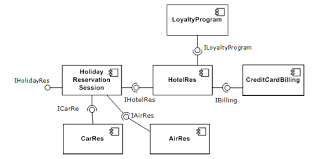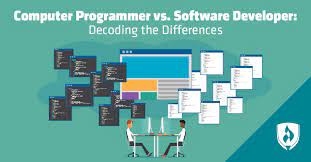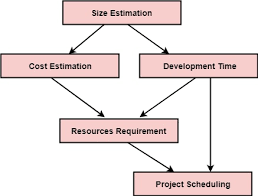Component-Based Software Engineering: Building for Reusability and Scalability
In the ever-evolving world of software development, the need for efficient and flexible approaches has become paramount. Component-Based Software Engineering (CBSE) has emerged as a powerful methodology that addresses these demands by promoting reusability, scalability, and maintainability.
At its core, CBSE revolves around the concept of building software systems by assembling pre-existing components rather than starting from scratch. These components are self-contained entities that encapsulate specific functionalities or services. By leveraging these reusable components, developers can save time and effort while ensuring consistent quality across projects.
One of the key advantages of CBSE is its focus on modularity. Components are designed to be independent entities with well-defined interfaces, allowing them to be easily integrated into larger systems. This modular approach enables developers to work on different components simultaneously, fostering collaboration and speeding up development cycles.
Another benefit of CBSE is the ability to enhance scalability. As software systems grow in complexity, it becomes crucial to handle increasing workloads efficiently. By using reusable components, developers can easily scale their applications by adding or removing components as needed. This flexibility allows for seamless adaptation to changing requirements without significant rework or disruptions.
Moreover, CBSE promotes code reuse across projects. Once a component is developed and tested thoroughly, it can be reused in multiple applications or systems. This not only saves time but also ensures consistency in functionality and performance across different projects. Developers can build upon existing components without reinventing the wheel, resulting in faster development cycles and improved productivity.
CBSE also facilitates maintenance and updates in software systems. Since each component is self-contained with a well-defined interface, modifications or bug fixes can be implemented without affecting other parts of the system. This reduces the risk of unintended consequences or regression issues when making changes to complex software architectures.
To implement CBSE effectively, organizations must establish robust component repositories that house well-documented and thoroughly tested components. These repositories serve as a centralized hub where developers can discover, evaluate, and integrate components into their projects. Additionally, organizations should invest in proper version control and dependency management systems to ensure smooth integration and avoid conflicts.
However, CBSE is not without its challenges. Identifying suitable components that meet specific project requirements can be a daunting task. Furthermore, integrating components from different sources may introduce compatibility issues or require additional effort for customization. It is crucial to have a clear understanding of the system’s architecture and requirements to select appropriate components and ensure seamless integration.
In conclusion, Component-Based Software Engineering offers numerous advantages in terms of reusability, scalability, maintainability, and productivity. By leveraging pre-existing components and modular design principles, developers can build robust software systems efficiently while adapting to changing needs. However, careful planning, proper documentation, and effective component management are essential for successful implementation of CBSE. With its potential to streamline development processes and enhance software quality, CBSE is undoubtedly a valuable approach in the modern software engineering landscape.
8 Essential Tips for Component-Based Software Engineering
- Start small and iterate
- Keep components loosely coupled
- Design for reusability
- Make sure components are testable
- Use version control and maintain clear documentation
- Use standard interfaces for communication between components
- Choose the right architecture for your system
- Monitor performance regularly
Start small and iterate
One of the key tips for successful Component-Based Software Engineering (CBSE) is to start small and iterate. This approach allows developers to gradually build and refine their software systems, ensuring that each component is thoroughly tested and integrated before moving on to the next.
Starting small provides several advantages. It allows developers to focus on a specific component or functionality, ensuring that it meets the requirements and performs as expected. By breaking down the system into smaller, manageable parts, developers can tackle one piece at a time, reducing complexity and potential errors.
Moreover, starting small enables faster feedback loops. Developers can quickly gather insights from users or stakeholders on the functionality and usability of individual components. This feedback can then be used to make necessary improvements or adjustments before moving forward with subsequent iterations.
By iterating through the development process, developers have the opportunity to continuously refine their components. They can identify any issues or limitations early on and address them promptly. This iterative approach also allows for flexibility in adapting to changing requirements or new insights gained during the development cycle.
Additionally, starting small and iterating helps manage risks effectively. By focusing on smaller components initially, developers can identify any potential challenges or bottlenecks early in the process. This mitigates the risk of encountering major issues later when multiple components are integrated into a larger system.
Furthermore, this approach promotes collaboration and communication among team members. As each component is developed and tested individually, it becomes easier for team members to collaborate effectively without stepping on each other’s toes. The modular nature of CBSE encourages parallel work streams while maintaining a clear understanding of dependencies between components.
However, it is important to strike a balance between starting small and delivering value incrementally. While it is beneficial to break down complex systems into manageable components, it is equally important not to lose sight of the bigger picture. Regularly reassessing project goals and milestones will ensure that progress aligns with overall objectives.
In conclusion, starting small and iterating is a valuable tip in Component-Based Software Engineering. By breaking down the system into smaller components, developers can focus on quality, gather feedback, manage risks effectively, and foster collaboration. This iterative approach allows for continuous improvement and adaptation to changing requirements. So, embrace this tip and watch your software system evolve into a robust and scalable solution.
Keep components loosely coupled
When it comes to Component-Based Software Engineering (CBSE), one essential tip that developers should always keep in mind is to ensure loose coupling between components. Loose coupling refers to the degree of dependency between components, and it plays a crucial role in the flexibility and maintainability of software systems.
In a loosely coupled architecture, components are designed to have minimal knowledge or reliance on other components. They communicate through well-defined interfaces, allowing for independent development, testing, and deployment. This approach offers several benefits.
Firstly, loose coupling promotes modularity and reusability. When components are decoupled from one another, they can be easily replaced or modified without affecting the entire system. This flexibility allows developers to adapt and evolve their software more efficiently, saving time and effort in the long run.
Secondly, loose coupling enhances scalability. As software systems grow or face changing requirements, loosely coupled components can be added or removed without disrupting the entire system. This modular approach enables developers to scale their applications by focusing on specific areas without impacting the overall functionality.
Furthermore, loose coupling improves maintainability. When changes are made to one component, there is a reduced risk of unintended consequences or ripple effects throughout the system. Developers can isolate modifications within individual components while maintaining overall system stability.
To achieve loose coupling in CBSE, it is essential to establish clear boundaries between components and minimize direct dependencies. This can be achieved by adhering to well-defined interfaces and avoiding tight integration or direct communication between components. Instead, communication should occur through intermediary mechanisms such as message passing or event-driven architectures.
However, it is important to strike a balance between loose coupling and excessive complexity. Overly decoupled systems may introduce additional overhead or performance issues due to excessive communication overhead or duplicated functionality across components. Therefore, careful consideration should be given when designing component interactions.
In conclusion, keeping components loosely coupled is a fundamental principle in Component-Based Software Engineering that promotes flexibility, reusability, scalability, and maintainability. By designing components with minimal dependencies and well-defined interfaces, developers can create software systems that are easier to modify, adapt, and scale. Embracing loose coupling as a guiding principle can lead to more robust and future-proof software architectures.
Design for reusability
Design for Reusability: Unlocking the Power of Component-Based Software Engineering
In the realm of software engineering, one principle stands out as a game-changer: design for reusability. When adopting a Component-Based Software Engineering (CBSE) approach, designing with reusability in mind can unlock significant benefits and revolutionize the way we build software systems.
Designing for reusability means creating software components that are modular, self-contained, and adaptable. These components should be designed to be independent entities with well-defined interfaces, allowing them to be easily integrated into different projects or systems. By focusing on reusability during the design phase, developers can lay the foundation for a more efficient and flexible development process.
The advantages of designing for reusability are numerous. First and foremost, it saves time and effort. Instead of starting from scratch each time a new project arises, developers can leverage existing components that have already been thoroughly tested and proven to work reliably. This not only accelerates development cycles but also reduces the risk of introducing new bugs or issues.
Moreover, designing for reusability promotes consistency across projects. By using standardized components with well-defined interfaces, developers ensure that functionality and behavior remain consistent throughout different applications or systems. This consistency not only improves user experience but also simplifies maintenance and updates by allowing changes to be made at the component level without affecting other parts of the system.
Designing for reusability also enhances scalability. As software systems grow in complexity or face increased workloads, having reusable components makes it easier to scale up or down as needed. Components can be added or removed without disrupting the entire system architecture, enabling seamless adaptation to changing requirements without significant rework.
Additionally, designing for reusability fosters collaboration within development teams. When components are designed to be modular and independent, multiple developers can work on different components simultaneously without stepping on each other’s toes. This parallel development approach not only speeds up the development process but also encourages knowledge sharing and cross-team collaboration.
To design for reusability effectively, it is essential to follow certain best practices. Components should have clear and well-defined interfaces, making it easy for other developers to understand how to use them. Additionally, thorough documentation and examples should be provided to aid in the integration and usage of components. Finally, regular testing and quality assurance processes should be in place to ensure that reusable components are reliable and perform as expected.
In conclusion, designing for reusability is a crucial tip when adopting a Component-Based Software Engineering approach. By creating modular, self-contained, and adaptable components, developers can unlock the power of reusability, saving time and effort while promoting consistency, scalability, and collaboration. With a focus on designing for reusability, software engineering teams can build more efficient, flexible, and robust systems that can adapt to the ever-changing demands of the digital landscape.
Make sure components are testable
When it comes to Component-Based Software Engineering (CBSE), one crucial tip that cannot be overlooked is ensuring that components are testable. Testing plays a vital role in software development as it helps identify bugs, ensure reliability, and validate the functionality of the system.
By making components testable, developers can have confidence in their stability and performance. Here’s why this tip is so important:
- Detecting Issues Early: Testable components allow for early detection of potential issues or bugs. By writing tests that cover different scenarios and edge cases, developers can identify problems before they propagate throughout the system. This helps minimize the impact of bugs on the overall software quality.
- Facilitating Maintenance: Testable components make maintenance easier and more efficient. When changes or updates need to be made, having a comprehensive suite of tests ensures that modifications do not inadvertently break existing functionality. Tests act as a safety net, allowing developers to refactor code confidently without introducing new errors.
- Promoting Collaboration: Testable components foster collaboration among team members. Well-written tests serve as executable documentation, providing insights into how components should behave and interact with other parts of the system. This enables developers to understand component dependencies and integration points, facilitating smoother collaboration between different teams working on various components.
- Enabling Continuous Integration and Deployment: With testable components, organizations can implement continuous integration and deployment (CI/CD) practices more effectively. Automated tests can be integrated into CI/CD pipelines to ensure that changes made to components do not introduce regressions or break existing functionality. This allows for faster delivery cycles while maintaining software quality.
To make sure components are testable, consider the following practices:
– Design components with clear interfaces: Well-defined interfaces make it easier to write tests that cover different input scenarios.
– Isolate dependencies: Components should have minimal dependencies on other parts of the system to enable isolated testing.
– Use mocking or stubbing techniques: Mocking or stubbing external dependencies can help create controlled environments for testing.
– Write comprehensive test suites: Develop a suite of tests that cover different scenarios, including edge cases, to ensure thorough coverage.
In conclusion, ensuring that components are testable is a crucial aspect of Component-Based Software Engineering. By prioritizing testability, developers can detect issues early, facilitate maintenance, promote collaboration, and enable efficient CI/CD practices. Embracing this tip will contribute to the overall quality and reliability of software systems built using CBSE principles.
Use version control and maintain clear documentation
When it comes to Component-Based Software Engineering (CBSE), two essential practices stand out as crucial for success: using version control and maintaining clear documentation.
Version control is a fundamental tool that allows developers to track changes made to software components over time. By utilizing version control systems like Git or Subversion, teams can easily manage different versions of components, track modifications, and collaborate effectively. This ensures that everyone involved in the development process has access to the most up-to-date version of each component.
Version control also plays a vital role in maintaining stability and reliability within a software system. It allows developers to roll back to previous versions if issues arise or if changes need to be reverted. This capability ensures that any unforeseen problems can be quickly addressed without impacting the overall project progress.
Additionally, clear documentation is essential for successful CBSE implementation. Documentation provides valuable information about each component’s purpose, functionality, interfaces, dependencies, and usage guidelines. It serves as a reference for developers who want to integrate or reuse components in their projects.
Well-documented components enable easier collaboration among team members by providing a clear understanding of how each component fits into the overall system architecture. They also facilitate troubleshooting and debugging processes by offering insights into potential issues or limitations associated with specific components.
Furthermore, documentation helps ensure continuity and maintainability of software systems. As teams change over time or new developers join a project, comprehensive documentation becomes an invaluable resource for understanding the design choices and implementation details of individual components.
By combining version control with clear documentation practices, organizations can reap significant benefits from CBSE. Version control allows for efficient tracking and management of component versions, while documentation ensures transparency and knowledge sharing within development teams.
In conclusion, using version control and maintaining clear documentation are indispensable tips when implementing Component-Based Software Engineering. These practices promote collaboration, stability, reliability, and maintainability within software projects. By embracing these principles, organizations can harness the full potential of CBSE and build robust, scalable, and reusable software systems.
Use standard interfaces for communication between components
One of the key principles in Component-Based Software Engineering (CBSE) is the use of standard interfaces for communication between components. This tip plays a crucial role in ensuring the seamless integration and interoperability of components within a software system.
Standard interfaces act as a common language that allows different components to communicate effectively. By defining clear and well-documented interfaces, developers can establish a set of rules and protocols for how components interact with each other. This promotes consistency, reduces complexity, and simplifies the overall development process.
Using standard interfaces offers several benefits in CBSE. Firstly, it enhances modularity by decoupling components from each other. Components can be developed independently as long as they adhere to the specified interface requirements. This allows for parallel development, where teams can work on different components simultaneously without dependencies on one another.
Secondly, standard interfaces enable component reusability. When components are built with standardized communication interfaces, they become more versatile and can be easily integrated into different systems or projects. Developers can leverage existing components without worrying about compatibility issues or extensive modifications.
Thirdly, standard interfaces facilitate system maintenance and updates. When changes need to be made to a specific component, having a well-defined interface ensures that other components relying on it will not be affected by the modifications. This minimizes the risk of unintended consequences or disruptions to the overall system.
Moreover, using standard interfaces promotes flexibility and scalability in software systems. As new requirements emerge or business needs change, developers can introduce new components that adhere to the established interface standards. These new components can seamlessly integrate with existing ones, allowing for easy expansion and adaptation without significant rework.
To effectively utilize standard interfaces in CBSE, it is essential to establish clear guidelines and documentation for their design and usage. These guidelines should define the expected inputs, outputs, data formats, protocols, and error handling mechanisms for each interface. Adhering to these standards ensures consistency across different components and promotes compatibility and interoperability.
In conclusion, the use of standard interfaces for communication between components is a valuable tip in Component-Based Software Engineering. It enhances modularity, promotes component reusability, facilitates system maintenance and updates, and enables flexibility and scalability. By establishing clear interface standards and guidelines, developers can build robust software systems that are modular, adaptable, and easily maintainable.
Choose the right architecture for your system
Choose the Right Architecture for Your System: A Key Tip in Component-Based Software Engineering
When it comes to Component-Based Software Engineering (CBSE), selecting the right architecture for your system is a critical factor that can greatly impact the success and efficiency of your development process. The architecture you choose sets the foundation for how components will interact, communicate, and collaborate within your software system.
The choice of architecture depends on various factors, including the nature of your project, its requirements, scalability needs, and future growth considerations. Here are a few key architectural patterns commonly used in CBSE:
- Layered Architecture: This architecture divides the system into logical layers, each responsible for specific functionalities. It promotes separation of concerns and modularity by organizing components based on their roles and responsibilities. This approach allows for easy maintenance, scalability, and reusability.
- Service-Oriented Architecture (SOA): SOA focuses on building systems as a collection of loosely coupled services that communicate with each other through standardized protocols. Each service represents a specific business functionality or capability and can be developed independently using different technologies. SOA enables flexibility, interoperability, and reusability of components across different systems.
- Event-Driven Architecture (EDA): EDA emphasizes communication between components through events or messages rather than direct method invocations. Components publish events when certain actions occur, while other components subscribe to these events and respond accordingly. EDA promotes loose coupling and responsiveness in systems with dynamic requirements.
- Microservices Architecture: In this architecture, a large system is decomposed into smaller, independent services that are responsible for specific functionalities or business processes. Each microservice operates as a separate entity with its own database if needed. This approach allows for independent development, deployment, scaling, and maintenance of individual services.
Choosing the right architecture involves considering factors such as system complexity, performance requirements, integration needs with external systems or legacy applications, team expertise, and future scalability. It is crucial to conduct a thorough analysis of your project’s specific requirements and constraints before making a decision.
Additionally, it is essential to keep in mind that architectures are not mutually exclusive. Hybrid approaches can be adopted by combining different architectural patterns to suit the unique needs of your system.
By selecting the appropriate architecture for your system, you lay the groundwork for effective component integration, collaboration, and scalability. A well-designed architecture ensures that components interact seamlessly, simplifies maintenance and updates, and allows for efficient development cycles.
In conclusion, when practicing Component-Based Software Engineering (CBSE), choosing the right architecture is a vital tip that can significantly impact the success of your software development process. Understanding the strengths and trade-offs of different architectural patterns will help you make informed decisions that align with your project’s goals and requirements. With the right architecture in place, you set yourself up for a solid foundation upon which to build robust and scalable software systems.
Monitor performance regularly
When it comes to Component-Based Software Engineering (CBSE), one crucial tip that developers should always keep in mind is to monitor performance regularly. Monitoring the performance of your software system is essential to ensure its efficiency, reliability, and scalability.
By regularly monitoring the performance of your components and the overall system, you can identify potential bottlenecks or areas of improvement. This allows you to proactively address any issues before they escalate and affect the user experience or system stability.
Performance monitoring involves measuring various metrics such as response time, resource utilization, throughput, and error rates. These metrics help you understand how your components are performing under different workloads and conditions.
Regular performance monitoring allows you to:
- Identify Performance Degradation: By comparing current performance metrics with baseline measurements, you can quickly detect any degradation in component or system performance. This helps you pinpoint the root cause of the issue and take appropriate actions to optimize or fix it.
- Optimize Resource Allocation: Monitoring performance helps you identify components or subsystems that consume excessive resources. By analyzing resource utilization patterns, you can optimize resource allocation and ensure efficient utilization of hardware and software resources.
- Plan for Scalability: As your software system grows in complexity and user base, monitoring performance becomes even more critical. It helps you understand how your components handle increasing workloads and whether they can scale effectively. By identifying potential scalability issues early on, you can plan for necessary upgrades or enhancements to accommodate future growth.
- Enhance User Experience: Performance directly impacts user experience. Slow response times or frequent errors can frustrate users and lead to dissatisfaction or abandonment of your application. Regularly monitoring performance allows you to identify areas where improvements are needed to enhance the overall user experience.
To effectively monitor performance in CBSE, consider implementing automated monitoring tools that provide real-time insights into component behavior and system health. These tools can generate alerts when predefined thresholds are exceeded, enabling proactive intervention to prevent performance degradation.
Remember, performance monitoring is an ongoing process. As your software system evolves and new components are introduced, it is crucial to continue monitoring and adapting your performance monitoring strategies accordingly.
In conclusion, monitoring the performance of your software system is a vital aspect of Component-Based Software Engineering. By regularly monitoring performance metrics, you can identify and address issues proactively, optimize resource allocation, plan for scalability, and enhance the overall user experience. Embrace performance monitoring as an integral part of your CBSE practices to ensure the success of your software projects.




